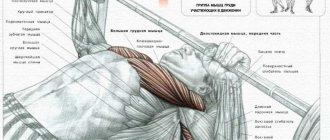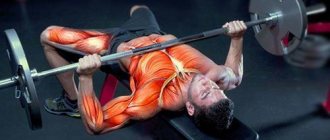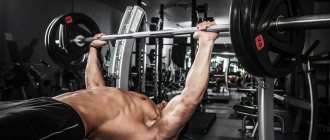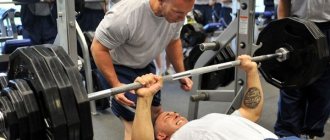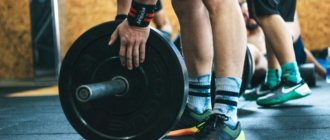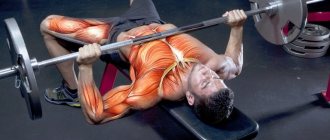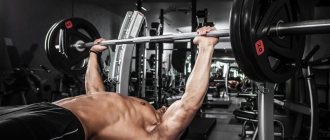If you want to know how to do and increase the bench press, this article will tell you everything you need to know about it.
“How much do you bench?”
If you have been training for a certain period of time, then you have probably been asked this question often. And you know without further clarification that they are asking about the results in the bench press.
Like it or not, nothing turns people's heads quite like lifting an impressive amount of weight on the bench press. And it seems that nothing frustrates beginners more than poor results in this exercise.
There's a reason why every well-designed training program includes the bench press as one of its main exercises. The importance of this exercise cannot be overestimated.
The fact is that the bench press is one of the best upper body exercises that develops the pectoral and latissimus muscles, shoulders, triceps and even to some extent the leg muscles.
If you are reading this article, then perhaps none of this is news to you. You are here because you want to improve your bench press performance and I can help you with that.
The first thing you need to know, although it may sound simple enough, the bench press is an exercise that requires some technique. If you don’t know what and how you are doing, then sooner or later you will stop making progress, unless, of course, you manage to avoid injury before then.
In this article, we'll talk about everything you need to know about the bench press to improve your bench press performance and get the most out of this exercise.
Video on how to bench press the most.
Let's start by discussing technique.
- Proper Bench Press Technique What Equipment is Suitable for the Bench Press? First, if possible, avoid using a Smith machine.
- Power frame is the best choice
- Bench and bar also matter
- Dumbbell Bench Press
- Correct psychological attitude
- Rest 3-4 minutes between sets.
Correct bench press technique
The bench press looks like a simple enough exercise, but how do you do the bench press correctly?
You lie on a bench with your feet flat on the floor, remove the bar from the racks, lower it to the center of your chest, and then press up.
This exercise can be performed in many ways, but, unfortunately, in most cases it is performed incorrectly.
Therefore, in order to analyze this exercise in detail, let's start with the equipment.
What Equipment is Suitable for the Bench Press?
Proper equipment has a significant impact on effective bench press performance.
First, if possible, avoid using a Smith machine.
The main disadvantage of the Smith machine is that it provides less muscle mass and strength gains compared to free weights.
One of the main reasons for this drawback is that the bar moves exclusively along a vertical fixed path. On the other hand, the free weight must be stabilized to prevent it from deviating from the correct trajectory.
When I used to bench press on the Smith machine, I never lifted more than 110kg for multiple reps. But when I first switched to free weights, I had a hard time lifting 80 kg.
This was a few years ago, and since then I have been benching up to 130 kg for 2-3 reps. The result is not outstanding, but quite decent.
Power frame is the best choice
A regular power rack will be an excellent choice, provided that you train with a spotter, because if you train without one, you will probably not be able to lift your maximum weight for fear of dropping the bar on yourself.
Even if you are an experienced athlete and know your strength well, when training to muscle failure there may be a situation where you feel like you can do one more repetition but fail.
Train in a power rack. Here is a classic example of a bench press power rack.
What makes this machine safe is the barbell lift control system. Set the limit bars to the desired height and they will prevent the apparatus from falling onto your chest when you fail a rep.
Here's how to do it:
Bench and bar also matter
Since we're on the subject of equipment, let's talk about the bench and bar.
You need to make sure that the bench is large enough to support your upper back and remain stable during the exercise. A bench 30 cm wide will do just fine.
Once again, I recommend the classic format bench:
If you are training at home, I recommend purchasing a high quality bar with arms that can rotate independently of the bar shaft. This way, the weight plates can rotate without rotating the bar, which would put more strain on the wrists.
Correct body position when bench pressing
With the equipment ready, it's time to talk about proper body positioning when performing the bench press. The first two steps are the following:
- Lie down on the bench so that your eyes are under the bar.
- Lift your chest, squeeze your shoulder blades together and press them into the bench.
You should feel tension in your upper back and you should maintain this position throughout the exercise.
- Grasp the bar with a grip slightly wider than shoulder width.
Hold the bar in your palms, closer to your wrists than your fingers, and squeeze it as tightly as you can.
The wrists should be straight and not bent towards the head. This will help prevent wrist pain.
A good way to check your grip width is to have someone stand behind you and look down at the position of your forearms at the bottom of the exercise.
Your forearms should be perpendicular to the floor. That is, like this:
As you can see, on the far left photo the position is too wide, on the middle one it is too narrow, and on the far right it is correct.
- Bend your lower back slightly and place your feet shoulder-width apart at right angles to your knees.
The back should not lie flat on the bench, and at the same time you should not bend it so much that the pelvis is almost under it.
Just maintain the natural curve that occurs when you arch your chest.
- With straight arms, lift the barbell from the racks and then move it in a horizontal line until it is directly above your shoulders.
Now you are ready to perform the bench press.
Do these movements every time you bench press, whether you're warming up or preparing to set a personal best.
This is good practice for developing proper technique, which will not only benefit the exercise, but also reduce the risk of injury.
How to lower weight correctly
The first thing you should know about arm movement when performing the bench press is the correct position of your elbows.
Many people make the mistake of spreading their elbows out to the sides, which can lead to shoulder injury. This mistake is the main reason why the bench press is considered a dangerous exercise for the shoulders.
A less common mistake is to place your elbows too close to your body, which robs you of stability and the ability to exert maximum force.
It is necessary that the elbows are located at an angle of 50-60° to the body. This will prevent the risk of injury and also provides a stable and secure position for performing the exercise. To better visualize this, look at the diagram:
If, at the lowest point of the exercise, the elbows are positioned at an angle of approximately 20º, then this is too close, and at an angle of 90º, it is too wide. The middle position at an angle of about 60° is optimal.
So now that you know the correct elbow position, let's get back to the exercise.
Keeping your elbows in the correct position, lower the bar to your lower chest near the nipples.
Yes, the bar should touch the chest! Forget about half reps!
You must control the movement of the bar as you lower it, but you should not lower it too slowly, because this will not have the best effect on muscle gain. Lower the bar for about 2 seconds.
How to properly remove the barbell and place it on the rack
Now that the bar has made contact with your chest (touched, not bounced off), you are ready to press the barbell up.
Although the name of the exercise suggests that you are supposed to “press” the barbell, it is better to imagine that you are pushing it.
That is, imagine that you are pushing your body away from the bar, and not vice versa. This will help you maintain proper technique and apply maximum effort.
The bar should make a slight arc, moving from the chest to the starting position in which it is easiest to balance.
Extend your elbows rather than keeping them slightly bent. This will prevent the risk of you dropping the weight.
When lifting the weight, the body maintains the above-described position: the shoulder blades remain pressed to the bench and brought together, the elbows are at the correct angle to the body, a slight arch in the lower back is maintained, the buttocks are on the bench, and the feet are on the floor.
How to properly place a barbell on a power rack
Do not try to place the barbell on the racks by squeezing the weight towards its stops, as you risk dropping the barbell on your face.
Always finish the rep first, and with the barbell over your shoulders and your arms extended, move it horizontally to the racks.
Let's summarize the above
To better imagine the whole process, watch the video. Here's what it all looks like in action:
Bench press. Strength training program.
The bench press is the king of upper body exercises. It's the most revered measure of a young weightlifter's lifting prowess and will add meat to the pecs, shoulders and triceps that few exercises can match.
It's no surprise that the bench press has reached an almost mythical status in most gyms, so much so that there is no doubt that there is currently a bill in Congress proposing to officially rename Monday as bench press day.
So why do so many lifters have tiny bird chests and max bench presses that match their IQ?
It's all about doing the bench press correctly. Not only using proper form, but proper weight selection, intelligent programming, appropriate assistance exercises, and understanding technique will all make or break bench press success for strength.
Form/Technique
It all starts with the right setup. Your setup and technique depends on whether your main goal is to move the most weight or build the biggest chest. The big difference between the two is the use of the arch. Powerlifters want to maximize their arc because it decreases the range of motion while increasing leverage, allowing more weight to be moved. Bodybuilders want a smaller arc to allow the muscles to work through a greater range of motion.
Installation and placement of legs
I'll cover the powerlifting system first since it is the more complex of the two.
- Lie down on a bench and grab the bar from below.
- Slide back along the bench and under the counter until the top ab area is directly under the counter.
- Pull your legs back under the bench directly under your hips so that the balls of your feet are in contact with the floor and your heels are lifted.
- Slide or “squeeze” your body back toward the bottom of the bench until your torso is in the correct position for the bench. At this point, your lower back should be arched quite high.
- Make sure your thighs are in contact with the bench and sink your traps and shoulder blades (which should be pressed tightly together) into the bench. This provides stability when carrying heavy weights and helps reduce the range of motion as he pushes his chest up while pulling his shoulders back.
- Adjust your grip, unscrew the bar, and perform a bench press for strength.
For bodybuilders:
- The feet can be placed either under the hips as described above, or flat on the floor in front of you.
- If you have trouble keeping your hips on the bench during a push-up, start with your feet on the bottom as this still allows for good leg movement but is more helpful in keeping your hips on the bench.
- Lie on your back and stick the traps into the bench for stability. There is no need for a large arc as you don't want to reduce your range of motion.
Foot Drive
Many lifters are confused about the foot drive and how to use it effectively.
- Whatever your leg position, keep your feet firmly planted on the floor and maintain moderate tension in your legs as you lower the bar to your chest.
- When the bar touches your chest, reverse the direction and push hard with your legs, pushing the bar away from your chest. This will help to "pop" out of the bar, while the added momentum will help push through the sticking point through the lockout.
Read also: Pectoral muscle training FST-7.
Bar's Path
Proper bar path is another aspect of the strength bench press that many athletes do not understand.
- The most mechanically efficient rod path is a gradual arc from the nipple line at the bottom to approximately above the base of the neck at closure. The exact points will vary slightly depending on the individual arms.
- To do this correctly, tuck your elbows out to the sides as you lower the bar, aiming for a spot just below your nipple line when the bar hits your chest.
- Lowering the bar must be done in the correct groove, as the body will naturally want to follow the same path as you press up. The concentric and eccentric portions of the bench press should look like a mirror image of each other.
- As you begin to move the barbell from your chest, keep your elbows tucked, but as you approach the middle, gradually rotate your elbows until they are fully flared. This should be done carefully, as flaring too quickly or too quickly will send the barbell back over your head and into the racks, stressing the shoulder joint.
Elbow Position
Flexing your elbows at the bottom reduces shoulder rotation and relieves tension on the shoulder joint. It also takes pressure off the pec tendon and reduces the likelihood of pec rupture, allowing you to lift more weight with improved leverage.
- When the bar is at your chest, your elbows, wrists and bar should be perfectly straight when viewed from the side.
- Don't let your wrists bend back. This not only puts stress on the wrist, but can also negatively impact the shoulder. On several occasions, big benchers have broken their arms using this technique.
Capture
While most lifters understand that using a wider grip will focus more on the chest and that a closer grip will target the triceps, few understand that the way you grip the bar affects muscle gain. Choosing the right grip will ensure that you are working with your own strengths and leverage, rather than against them.
- There are three different ways to grip the bar: full grip (thumb wrapped around the bar), false or no thumb (thumb behind the bar), and thumb extended along the bar.
- Regardless of your grip, always try to squeeze the barbell tightly and push it apart as if trying to push the barbell apart. This will help engage your triceps.
- Changing the position of the thumb affects the position of the elbow. A full grip rotates the arm outward to a greater degree, thereby rotating the elbows outward and emphasizing the chest.
- With a thumbless grip, the arms are turned more toward the body, making it easier to pull the elbows in on the way down and engage the triceps.
- Gripping the bar with your thumb along the bar is a compromise between the two. Thus, an athlete with a comparatively stronger chest (or someone who wants to work the chest to the highest degree) will benefit from a wide, full grip, while an athlete with extremely strong triceps will get the most benefit from a relatively narrow, thumbless grip.
Read also: 10 best exercises for the chest muscles.
Assistance Exercises
The strengths and weaknesses of the athlete determine the assistance exercises.
Maintaining structural balance helps prevent injury by allowing you to lift the most weight. Identifying your weak spots on the bench is relatively easy, assuming the problem is not technical.
- Difficulty blocking weights in the upper region is usually associated with relative weakness in the triceps, while difficulty moving weights in the lower region is usually associated with weak chests.
- A bar that barely emerges from the chest can be considered a latent weakness, suggesting that the problem is not one of form or ego. However, if you unpack the bar and it pins you to the bench, chances are you're just not being realistic as far as your true strength level is concerned.
Strengthening Your Lockout
Reverse Belt Presses
My favorite exercise to correct lockout weakness is reverse presses. Even though the exercise focuses on locking, it still allows you to work through a full range of motion and press the barbell in a normal groove. It also teaches you how to push the barbell explosively off your chest. If you don't do this, the momentum from the bands will be lost and it will be very difficult to lock in the weight.
- To perform this exercise, set up a bench with dumbbells inside a rack.
- Secure a couple of strong bands around the top of the force cage (one on each side) and secure them around the ends of the rod where you would normally place the collars.
- This setup typically takes about 150 pounds from the bar at chest level and almost nothing when locked out, depending on cage height, bench height, and arm length.
Onboard Presses
Side presses are very effective at securing your lock. Depending on the length of your arm and where exactly the barbell sits, use between 2-5 planks (depending on thickness) when performing this exercise.
Typically, the boards are made from 2" x 6" pine boards and are usually nailed, screwed or glued together to achieve the desired thickness. I have found that creating a pressing area that is about 18 inches long and having a 6 inch handle works well.
- To perform this exercise, simply have your partner hold the boards across their chest while benching. If you don't have a partner, the boards can be easily held in place by securing them to your chest with a single knee wrap tied around you.
Strengthening the lower abdomen
Technical issues aside, the ability to push the barbell away from the chest is largely dependent on the pectoral muscles.
- Any exercise that allows you to work through a greater range of motion will usually help improve the pop in your chest. The preferred methods are the dumbbell press and the use of a curved barbell.
- The dumbbell press prevents the lifter from bouncing off the bar and allows for a greater range of motion, allowing the lifter to get a deeper stretch at the bottom of the movement.
- The curved bar is also called the "MacDonald Bar" in honor of legendary bencher Mike McDonald. MacDonald once held every world bench press record from 181 pounds to 242 pounds. The bar has a 2″ sag, allowing the lifter to lower the bar 2″ further than with a standard barbell.
Read also: Training plan for the pectoral muscles: 4 weeks.
You must be careful when using the MacDonald barbell for the first time, otherwise injury can easily occur due to the increased range of motion. Additionally, expect that the amount of weight you can use with a MacDonald barbell will initially be significantly less than your regular bench, especially if your main weakness is at the bottom of the lift.
Programming
Effective programming for the bench press requires well-planned development, prevents overtraining, stimulates hypertrophy, and reinforces proper technique. I have used the following program with clients who want to add pounds to their bench press and extra muscle mass. It is not uncommon for this program to see a 20-50 pound increase in bench press weight over a 16 week training period.
The main thing is to start with the exact Max. Often lifters overestimate their maximum or use a number they were previously capable of. It is very important to use the current true maximum obtained using the correct form. Failure to do this will only lead to overtraining and difficulty progressing from week to week.
Simply put, to get the most out of this program, you better check your ego.
16 Week Program for Bench Press Strength
- Week 1: 5 x 10 x 60% (5 sets of 10 reps @ 60% bodyweight)
- Week 2: 5 x 8 x 65%
- Week 3: 5 x 5 x 70%
- Week 4: 5 x 3 x 75%
- Week 5: 5 x 10 x 60%
- Week 6: 5 x 8 x 70%
- Week 7: 5 x 5 x 75%
- Week 8: 5 x 3 x 80%
- Week 9: 5 x 10 x 60%
- Week 10: 4 x 8 x 75%
- Week 11: 4 x 5 x 80%
- Week 12: 4 x 3 x 85%
- Week 13: 5 x 10 x 60%
- Week 14: 3 x 8 x 80%
- Week 15: 3 x 5 x 85%
- Week 16: 3 x 3 x 90%
conclusions
Pressing heavy weights creates crazy strength and mass in the upper body, and is just a hell of a lot of fun. The lifters I know who say they don't care about bench press numbers usually have pecs that feel like deflated balloons and have a hard time supporting their body weight.
Funny how this happens.
Don't fall into this trap of sour grapes negativity. Check your ego and learn how to sit on the bench correctly, and finally find out where you are weak. And then get to work.
Thank goodness for the bench press - only 16 weeks!
Types of bench press
The standard barbell bench press is a staple exercise in many strength training programs, but it is usually accompanied by several variations.
Let's look at the most common options.
Dumbbell Bench Press
Although this exercise is not a direct replacement for the bench press, the dumbbell press is still an exercise that deserves attention.
One of the main problems that athletes face when performing this exercise is maintaining heavy dumbbells in the correct position.
This is what it looks like:
In terms of training routine, I usually alternate dumbbell presses with barbell presses for my shoulder workouts.
For example, I do 3-4 sets of incline dumbbell presses, 3-4 sets of flat bench presses, 3-4 sets of weighted dips for 8 weeks. Then for 8 weeks I will do 3-4 sets of flat bench press, 3-4 sets of incline bench press and 3-4 sets of flat dumbbell press.
Close grip bench press
The narrower the grip, the more load is placed on the triceps.
This grip is not desirable if you are focusing on training the chest, but it is one of my favorite ways to train the triceps. And by the way, strong triceps guarantee good results in the standard bench press.
A close grip means that you should grip the bar slightly narrower than shoulder width.
You may see some lifters holding the bar with their arms just a few inches apart. This is a bad idea because this grip puts the wrists and shoulders in a very weak and risky position.
All other recommendations regarding the technique of performing the exercise remain the same: shoulder blades pressed firmly to the bench, a slight arch in the lower back, feet on the floor, the bar describes a small arc as it lowers, touches the lower chest, and then rises back.
If you feel discomfort in your wrists or shoulders at the bottom of the exercise, simply widen your grip by about a finger's width and continue the exercise.
If you still feel discomfort, increase your grip width again by a finger's width and repeat until you find a position that is comfortable for you.
Here's a good instructional video:
Incline Bench Press
The upper chest debate is one of the “controversial” aspects of bodybuilding.
Do I need to do chest exercises to work the upper part of the chest? Or do all the chest exercises to pump up every possible muscle fiber? And even more than that – is there such a thing as “upper chest”?
I'll try to explain briefly.
There is a part of the pectoral muscle that is what we call the “top of the chest.” It is located in the collarbone area and looks like this:
Although these muscles are part of the pectoralis major muscle, their fibers are quite different. Thus, some exercises can focus on the main muscles of the chest, while others on the clavicular part.
Notice that I said emphasis rather than isolation, because exercises that work the first or second part of the muscle will affect both parts to a certain extent.
However, proper development of the chest muscles requires working out the muscles of the upper part for two simple reasons:
- working out these small, stubborn muscles takes longer;
- The best exercises for these muscles are also great for developing the pectoralis major muscles.
The best way to ensure that the upper chest does not lag behind the rest of the pectoral muscles is to perform incline bench presses frequently.
The reverse grip press will also help you with this, and we'll talk about that soon.
That's why the incline press is such a big part of my Bigger, Leaner, Stronger and Leaner, Leaner, Stronger programs, and why I'll be recommending the same thing here.
When performing a bench press on an inclined bench, the angle of the bench should be 30-45°.
I prefer an angle of 30°, others like an angle of about 45°. I recommend that you try different angles in this range and find the one that works best for you.
All other recommendations regarding equipment and technique for performing the exercise remain the same as for performing a regular bench press, with a few exceptions:
- The bar should go past the chin and touch the body just below the collarbone. This will ensure the bar moves vertically.
Here is a video showing the correct execution of a barbell bench press on an incline bench:
And also with dumbbells:
Upside Down Incline Bench Press
The overhead bench press is a popular exercise among some athletes, but I am not one of them. Due to the reduced range of motion, this exercise is less effective than a regular or incline press.
The main argument given for this exercise is that it develops the lower part of the pectoralis major muscle, but I prefer to do dips for this exercise.
The bottom line is that you will never get great chest size if you only do bent over presses.
Reverse grip bench press
The reverse grip press has its advantages, which are often overlooked.
You should wrap your palms around the bar, which will not only reduce the stress on your shoulders, but will also work your upper chest more effectively.
Here's how to do it:
Calculator for calculating one repetition with maximum weight (1RM) in the bench press
The only 100% accurate way to know how much weight you can bench press for a certain number of reps is to simply do the exercise. But there are several formulas that can predict results with a fair amount of subtlety.
The most commonly used formulas are Brzycki, Bachley and dos Remedios.
Use the calculator to predict your 1RM.
Weight lifted: _____ ○ lbs. ○ kilograms.
Number of repetitions: ____
| 1RM | |||||||
| 95% 1RM | 90% 1RM | 85% 1RM | 80% 1RM | 75% 1RM | 70% 1RM | 65% 1RM | 60% 1RM |
| Estimated reps and weight based on 1RM | ||||||||||||
| Repetitions | 1 | 2 | 3 | 4 | 5 | 6 | 7 | 8 | 9 | 10 | 15 | 20 |
| Brzycki | ||||||||||||
| Bachley | ||||||||||||
| Dos Remedios | ||||||||||||
If you're wondering how to measure your performance, here's a handy guide.
The following figures are indicators that can reasonably be expected from people with various levels of training.
| 1RM Bench Press for Adult Men | |||||
| Body weight | Without preparation | Newbie | Average level | Advanced | Professional |
| 67 | 49 | 64 | 78 | 106 | 132 |
| 75 | 54 | 69 | 85 | 102 | 145 |
| 82 | 58 | 74 | 91 | 125 | 156 |
| 90 | 61 | 78 | 97 | 131 | 164 |
| 100 | 64 | 83 | 102 | 139 | 173 |
| 110 | 68 | 86 | 105 | 143 | 179 |
| 1RM Bench Press for Adult Women | |||||
| Body weight | Without preparation | Newbie | Average level | Advanced | Professional |
| 52 | 26 | 35 | 39 | 49 | 51 |
| 56 | 27 | 35 | 41 | 53 | 64 |
| 60 | 29 | 37 | 43 | 55 | 68 |
| 67 | 32 | 41 | 48 | 61 | 75 |
| 75 | 34 | 44 | 51 | 66 | 83 |
| 82 | 37 | 47 | 55 | 72 | 87 |
The “no preparation” column shows the expectation for those who have not bench pressed before.
The "average" column shows the standard strength level for those with several years of bench press experience.
The “professional” column contains indicators for competitive athletes (1% of athletes).
A Simple and Effective Bench Press Training Program
Before I end this article, I want to share with you a simple and effective bench press workout program that will help make your chest bigger and stronger.
Here she is:
Day 1:
- Incline bench press: warm up, then 3 sets of 4-6 reps (80-85% of 1RM);
- Incline dumbbell press: 3 sets of 4-6 reps;
- Barbell bench press: 3 sets of 4-6 reps.
Day 3:
- Close Grip Press: 3 sets of 4-6 reps
Day 4
- Barbell bench press: 3 sets of 8-10 reps (70-75% of 1RM);
- Military press standing or seated: 3 sets of 4-6 reps;
Yes, just 15 heavy chest sets per week. This load may seem easy to you, but try it - it's harder than you think.
Special exercises and techniques
A very effective exercise that will help you bench press more is the barbell floor press . To perform it, you need a power frame, on the racks of which a barbell is installed at the height of straight arms, and the athlete takes a place lying on the floor. Having removed the barbell, the athlete performs a classic barbell press. A special feature of the exercise is that the elbows rest on the floor, which completely eliminates the possibility of triceps assistance.
Bench press with fixed amplitude points . This is a variation of the barbell press in which the athlete, while performing movements, pauses or even several pauses during the approach. Pauses are made for one or two seconds. Thanks to stops, the athlete is forced to make more effort to lift the barbell, eliminating inertia. A great example would be pushing a car. The most difficult thing in this matter is to push the car from a dead point. And in this exercise, a person has to do this several times in one repetition.
Another option that can be included in your training program to increase bench weight is to use a high-intensity training regimen . It involves the use of set modifications (supersets, trisets and dropsets are used), reducing rest time and reducing training time. This workout should be performed with heavy weights, amounting to 70-80 percent of the maximum. Naturally, the number of repetitions should be minimal. This method is not highly effective in increasing working weights in the bench press, but this technique will help create additional stress necessary for increasing strength and volume.
